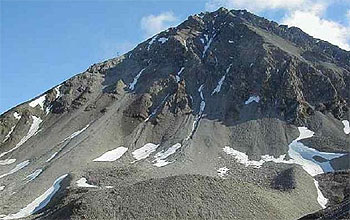|

Press Release 04-153
Research Team Discovers First Evidence of Microbes Living in a Rock Glacier

December 13, 2004
Arlington, Va.-- Scientists have discovered evidence of microbial activity in a rock glacier high above tree line in the Rocky Mountains, a barren environment previously thought to be devoid of life.
Found in an intermittent stream draining from the glacier, the evidence includes traces of dissolved organic material and high levels of nitrates, said Mark Williams, a scientist at Colorado University (CU)-Boulder. The high nitrate levels are believed to be a result of microbes metabolizing nitrogen within the glacier, said CU-Boulder graduate student Meredith Knauf.
Knauf will give a presentation on Dec. 13 about the discovery, at the Fall Meeting of the American Geophysical Union, held Dec. 13 to Dec. 17 in San Francisco, Calif.
Rock glaciers are large masses of rock debris interspersed with ice in the high mountains of temperate areas. Moving at speeds of just inches or a few feet a year, rock glaciers require an extremely cold environment, large amounts of rock debris and enough of a slope to allow them to slide.
Williams said the microbial "signature" discovered by the team in the rock glacier, located in the Green Lakes Valley watershed 30 miles west of Boulder, Colo., is similar to that found recently in semi-frozen lakes in the Dry Valleys of Antarctica. The unexpected discovery of microbes in that hostile Antarctica region has enthused scientists hunting for life in inhospitable environments, he said.
The Green Lakes Valley watershed is part of the Niwot Ridge Long-Term Ecological Research (LTER) site supported by the National Science Foundation (NSF). Niwot Ridge is the only one of NSF's 26 LTER sites worldwide that is located in a sub-alpine and alpine environment.
"The finding that similar microbes occupy similar habitats in Colorado and Antarctica should spur other discoveries elsewhere in these environments," said Henry Gholz, director of NSF’s LTER program. "The challenge now is to explain the role of these microbes in the ecosystem."
Added Williams, “Rock glaciers are not biological deserts as had been previously thought. This is one more example that microbes can live in the most extreme of environments."
Both the amount of dissolved organic matter and nitrate levels from microbial activity in the rock glacier rose dramatically from the late spring to the early fall in 2003, said Knauf. "This increase indicates that the biological signal is coming from meltwater inside the rock glacier, rather than from terrestrial microbial activity in the tundra around it," she said.
The dissolved organic carbon molecules from the rock glacier, which are large and complex, are very similar in structure to molecules found by the researchers in Antarctica, said Knauf. "The microbial activity we are seeing appears to be much more like what researchers have found in the Dry Valleys of Antarctica than anything found in North American temperate areas," she said.
Microbes, which are microscopic, single-celled organisms, have been found in boiling water in deep-sea ocean vents, clinging to ice in subterranean polar lakes and living in rocks two miles underground. Such microbes, known popularly as "extremophiles," also have been found living inside of nuclear reactors and even in the brickwork of 4,800-year-old Peruvian pyramids.
Because scientists suspect that Earth's most extreme environments resemble environments found on distant planets, such examples of extremophiles on Earth have caught the interest of astrobiologists, said Williams. "Parts of Antarctica are seen as an analog to environments on Mars by researchers, and we see this rock glacier environment as a new analogue to Antarctica," he said.
Microbes, which have been shown to metabolize elements like iron, nitrogen and sulfur, appear to require water in order to live, grow and reproduce. Previously at the Niwot Ridge study area, microbes living under the tundra snow pack have been shown to be active in sub-zero conditions, breaking down plant material and metabolizing nitrogen in the dead of winter, Williams said.
After the discovery in the Green Lakes Valley, the CU-Boulder research team discovered evidence of microbial life in rock glaciers in southern Colorado and in Wyoming, said Knauf.
Other CU-Boulder researchers involved in the study include Nel Caine, Rose Cory and Fengjing Liu.
-NSF-

Media Contacts
Cheryl L. Dybas, NSF (703) 292-8070 cdybas@nsf.gov
Jim Scott,, CU-Boulder (303) 492-3114 jim.scott@colorado.edu
Program Contacts
Henry L. Gholz, NSF (703) 292-8481 hgholz@nsf.gov

The National Science Foundation (NSF) is an independent federal agency that supports fundamental research and education across all fields of science and engineering. In fiscal year (FY) 2009, its budget is $9.5 billion, which includes $3.0 billion provided through the American Recovery and Reinvestment Act. NSF funds reach all 50 states through grants to over 1,900 universities and institutions. Each year, NSF receives about 44,400 competitive requests for funding, and makes over 11,500 new funding awards. NSF also awards over $400 million in professional and service contracts yearly.
 Get News Updates by Email Get News Updates by Email
Useful NSF Web Sites:
NSF Home Page: http://www.nsf.gov
NSF News: http://www.nsf.gov/news/
For the News Media: http://www.nsf.gov/news/newsroom.jsp
Science and Engineering Statistics: http://www.nsf.gov/statistics/
Awards Searches: http://www.nsf.gov/awardsearch/
| 

